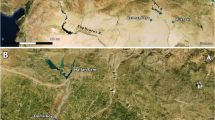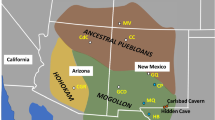Abstract
Multidisciplinary investigations at the Los Ajos archaeological mound complex in the wetlands of southeastern Uruguay challenge the traditional view that the La Plata basin was inhabited by simple groups of hunters and gatherers for much of the pre-Hispanic era1,2,3,4. Here we report new archaeological, palaeoecological and botanical data indicating that during an increasingly drier mid-Holocene, at around 4,190 radiocarbon (14C) years before present (bp), Los Ajos became a permanent circular plaza village, and its inhabitants adopted the earliest cultivars known in southern South America. The architectural plan of Los Ajos during the following Ceramic Mound Period (around 3,000–500 14C yr bp) is similar to, but earlier than, settlement patterns demonstrated in Amazonia5,6,7,8,9,10, revealing a new and independent architectural tradition for South America.
This is a preview of subscription content, access via your institution
Access options
Subscribe to this journal
Receive 51 print issues and online access
$199.00 per year
only $3.90 per issue
Buy this article
- Purchase on Springer Link
- Instant access to full article PDF
Prices may be subject to local taxes which are calculated during checkout




Similar content being viewed by others
References
Meggers, B. & Evans, C. in Ancient Native Americans (ed. Jennings, J.) 543–591 (Freeman, San Francisco, 1978)
Schmitz, P. I. J. Prehistoric hunters and gatherers of Brazil. J. World Prehist. 1, 53–126 (1987)
Steward, J. & Faron, C. Native Peoples of South America (McGraw-Hill, NewYork, 1959)
Willey, G. An Introduction to American Archaeology Vol. II (Prentice Hall, New Jersey, 1971)
Heckenberger, M. J. et al. Amazonia 1492: pristine forest or cultural parkland? Science 301, 710–714 (2003)
Roosevelt, A. C. Moundbuilders of the Amazon (Academic, San Diego, 1991)
Wüst, I. & Barreto, C. The ring villages of central Brazil: a challenge for Amazonian archaeology. Latin Am. Antiq. 10, 3–23 (1999)
Spencer, C. & Redmond, E. Prehispanic causeways and regional politics in the Llanos of Barinas, Venezuela. Latin Am. Antiq. 9, 95–110 (1998)
Erickson, C. L. in Archaeology of the Lowland American Tropics (ed. Stahl, P.) 66–95 (Cambridge Univ. Press, Cambridge, 1995)
Lehmann, J., Kern, D., Glaser, B. & Woods, W. Amazonian Dark Earths. Origin, Properties, Management (Kluwer Academic, New York, 2003)
Moseley, M. The Maritime Foundations of Andean Civilization (Cummings, California, 1974)
Dillehay, T. D., Netherly, P. & Rossen, J. Middle Preceramic public and residential sites on the forested slope of the western Andes, northen Peru. Am. Antiq. 54, 733–759 (1989)
Lathrap, D. J., Marcos, J. & Zeidler, J. Real Alto: An ancient ceremonial center. Archaeology 30, 2–13 (1977)
Solis, R. S., Hass, J. & Creamer, W. Dating Caral, a Preceramic site in the Supe valley on the central coast of Peru. Science 292, 723–726 (2001)
Bracco, R. “Proyecto Arqueología de la Cuenca de la Laguna Merín”. (Tech. Rep. PROBIDES, Uruguay, Rocha, 1993)
Stuiver, M. et al. INTCAL98 radiocarbon age calibration, 24000–0 cal BP. Radiocarbon 40, 1041–1083 (1998)
López, J. M. Las Estructuras Tumulares (Cerritos) del Litoral Atlántico Uruguayo. Latin Am. Antiquity 12, 231–255 (2001)
Bracco, R., López, J. M. & Cabrera, L. in Arqueología de las Tierras Bajas (eds Duran, A. & Bracco, R.) 13–38 (Ministerio de Educación y Cultura, Montevideo, 2000)
Bracco, R. & Ures, C. in Arqueología y Bioantropología de las Tierras Bajas (eds López, J. & Sans, M.) 13–33 (Universidad de la República, Montevideo, 1999)
Iriarte, J. Mid-Holocene Emergent Complexity and Landscape Transformation: The Social Construction of Early Formative Communities in Uruguay, La Plata Basin. Unpublished PhD dissertation, Univ. Kentucky (2003)
Sandweiss, D., Maasch, K. & Anderson, D. G. Transitions in the mid-Holocene. Science 283, 499–500 (1999)
Pearsall, D., Chandler-Ezell, C. & Chandler-Ezel, A. Identifying maize in neotropical sediments and soils using cob phytoliths. J. Archaeol. Sci. 30, 611–627 (2003)
Piperno, D. R., Ranere, A., Holst, I. & Hansell, P. Starch grains reveal early root crop horticulture in the Panamanian tropical forest. Nature 407, 894–897 (2000)
Piperno, D. R. & Stothert, K. Phytolith evidence for early Cucurbita domestication in southwest Ecuador. Science 299, 1054 (2003)
Iriarte, J., Holst, I., López, J. M. & Cabrera, L. in Enduring Records: The Environmental and Cultural Heritage of Wetlands (ed. Purdy, B.) 61–70 (Oxbow Books, Oxford, 2001)
Iriarte, J. Assessing the feasibility of identifying maize through the analysis of cross-shaped size and tridimensional morphology of phytoliths in the grasslands of southeastern South America. J. Archaeol. Sci. 30, 1085–1094 (2003)
Pearsall, D. Paleoethnobotany: A Handbook of Procedures (Academic, San Diego, 2000)
Piperno, D. R. Phytolith Analysis: An Archaeological and Geological Perspective (Academic, San Diego, 1988)
DeBlasis, P., Fish, S. K., Gaspar, M. D. & Fish, P. R. Some references for the discussion of complexity among the Sambaqui moundbuilders from the southern shores of Brazil. J. Am. Archaeol. 15, 75–105 (1998)
Scmitz, P. I., Rogge, J. H., Osorio, A. & Beber, M. V. Aterros Indigenas no Pantanal do Mato Grosso de Sul (Instituto Anchietano de Pesquisas, Antropologia No. 54, Sao Leopoldo, Rio Grande do Sul, Brazil, 1998)
Acknowledgements
Supported by grants from the National Science Foundation, Wenner-Gren Foundation for Anthropological Research, Smithsonian Tropical Research Institute, and the University of Kentucky Graduate School. J.I. received support from the Comisión Nacional de Arqueología, Ministerio de Educación y Cultura, Uruguay and the Rotary Club of Lascano, Rocha, Uruguay. We thank T. Dillehay, C. Mañosa, E. Moreno, H. Ciganda and G. Uriarte for their support.Author contributions J.I. directed the multidisciplinary research and conducted the archaeological, lithic and phytolith analyses. I.H. undertook the starch grain analysis, C.L. did the pollen analysis, O.M. directed the lithic debitage and ceramic analysis, A.R. carried out the faunal analysis and E.A. collected and identified the selected plant species to build the phytolith reference collection of southeastern Uruguay.
Author information
Authors and Affiliations
Corresponding author
Ethics declarations
Competing interests
The authors declare that they have no competing financial interests.
Supplementary information
Supplementary Tables 1 and 2
Supplementary Table 1. Detailed Phytolith Counts and Percentages from Mound Gamma; Supplementary Table 2. TBN Trench Cross-shaped Phytoliths Discriminant. (DOC 329 kb)
Supplementary Figure 1
View of (a) the central part of Los Ajos from S to N and (b) the TBN crescent-shape rise trench excavation in progress from N to S. (JPG 69 kb)
Supplementary Figure 2
Selected pollen and phytolith percentage diagram from Los Ajos core. (JPG 75 kb)
Supplementary Figure 3
Plant-grinding tools from Mound Gamma. (JPG 54 kb)
Rights and permissions
About this article
Cite this article
Iriarte, J., Holst, I., Marozzi, O. et al. Evidence for cultivar adoption and emerging complexity during the mid-Holocene in the La Plata basin. Nature 432, 614–617 (2004). https://doi.org/10.1038/nature02983
Received:
Accepted:
Issue Date:
DOI: https://doi.org/10.1038/nature02983
This article is cited by
-
Chemical analysis of pottery reveals the transition from a maritime to a plant-based economy in pre-colonial coastal Brazil
Scientific Reports (2023)
-
Pre-Columbian Mounds Harbor Distinctive Forest Communities in the Southern Campos of American Pampas
Human Ecology (2023)
-
A New Methodological Approach to Detect Microcenters and Regions of Maize Genetic Diversity in Different Areas of Lowland South America
Economic Botany (2023)
-
The history of agriculture in the mountainous areas of the lower Yangtze River since the late Neolithic
Frontiers of Earth Science (2022)
-
Relationships among American popcorn and their links with landraces conserved in a microcenter of diversity
Genetic Resources and Crop Evolution (2020)
Comments
By submitting a comment you agree to abide by our Terms and Community Guidelines. If you find something abusive or that does not comply with our terms or guidelines please flag it as inappropriate.



